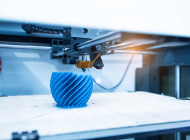
Support structures is an important aspect to produce successful 3D printed parts. Although the key advantage of using 3D printing is the ability to create parts with freeform designs and intricate geometries, some of its design freedom wouldn’t be possible without using support structures.
It is a must to consider using support structures as part of the 3D printing process. In order to understand more about support structures, here is a blog post about how support structures affect 3D printing process.
What are support structures
Support structures or scaffolding supports the 3d object during 3D printing. Engineers have been using support structures for hundreds of years to support different infrastructures such as buildings, bridges, etc.
Why use support structures during 3d printing process
Support structures are disposable structures that are used to prop up overhanging features. It helps ensure the printability of any 3D part. It also prevents part deformation, secures a 3D part to the printing bed and ensures that they are attached to the main body of the printed part.
Drawbacks of using support structures
Using support structures also has a number of disadvantages. First, it increases time required for the whole construction/printing process. This means, the more complex the support structure, the more time-consuming the 3D printing procedure will be.
Another disadvantage is the tendency of having dimensional inaccuracies. Some support structures are difficult to remove. Sometimes, after removing, there may be remaining marks that can affect the appearance and the surface quality of the 3D part. Thus, it is important to have post-processing procedure to polish its surface. When it comes to post-processing, expertise is also required to get the polishing job done properly.
Using support structures also means more wastage of materials. It creates excess materials that often cannot be reused.
When to use support structures
Support structures are needed when 3D models have steep overhangs or unsupported areas. For example, Printing a 3D part with an arch design requires support material. This is because there would be nothing else to support the top layer of the arch.
Consequently, if you try to print the arch without support structure, then the top layer will sag and droop since there will be no support below it.
For extrusion-based printers, the general rule is that if the overhang has an angle of less than 45 degrees, support structures are not necessarily required. However, for steeper overhangs, you may want to consider adding support structure to the part especially when you notice that the edges of the layer begin to deform.
Support structures for different printing methods
When adding support structures, the 3D printing technology to be used should also be considered.
Fused Deposition Modelling
Support structures are required for FDM printing specifically if it has overhangs of more than 45ᵒ or with bridges of greater than 5mm. Most support structures can be manually removed or can be dissolved in water or chemical.
SLS and Binder Jetting
These 3D printing technologies may not require support structures. This is because during the printing process, the powder bed itself provides support for the model. After 3d printing, it can be lifted out and cleaned.
Direct Metal Laser Sintering
In the case of DMLS, although it uses powder bed like SLS, using support structure is still required. This is to ensure that the parts are attached securely to the printing bed. Apart from that, using support structures will also ensure that heat is dissipated properly and help prevent deformation.
Stereolithography
It is necessary to add support structures when printing with SLA. The main reason is to avoid any deformation and make sure that the parts are attached properly to the printing bed.
Conclusion
Using support structures can be of great help especially during the printing process. It is needed when printing complex overhangs and bridges on the 3D model.
There may be challenges when it comes to deciding when and where it should be added. But, optimizing the support structure during the design process can be a solution.
If you need further help with your 3D printing projects, do not hesitate to call a 3D printing service provider. They can offer you services such as 3D design modelling, custom 3D printing and many more.








